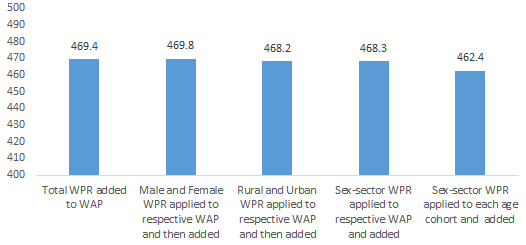Prior to the 2017-18 Periodic Labour Force Survey, there was paucity of official, labour-market data since the last nationally representative survey was from 2011, and other surveys in the intervening period indicated varying estimates. In this post, Basole and Nath identify the main factors driving these differences, and highlight the most salient feature of employment during 2011-2018 – massive withdrawal of women from subsidiary agricultural work.
The release of the first round of the new Periodic Labour Force Survey (PLFS, 2017-18) just after the 2019 general election, generated an unprecedented amount of debate on the employment situation in India. There had been paucity of official information on the state of the labour market since the last NSS (National Sample Survey) Employment and Unemployment Survey (EUS, 2011-12). When this new dataset finally arrived showing a sharp rise in the unemployment rates and a fall in the workforce participation rate (WPR), these trends grabbed the headlines. However, despite several articles and research papers on the issue, some key questions related to job creation still remained unclear. Was there, in absolute terms, a rise or a decline in the number of people employed between 2011-12 and 2017-18? By how much? If there was an increase, had it kept pace with the growth in the working-age population? Using the same data sources (EUS, 2011-12 and PLFS, 2017-18) different authors come up with very different estimates. According to Bhandari and Dubey (2019), the size of the workforce increased by 23 million. On the other hand, Mehrotra and Parida (2019), Himanshu (2019), and Kannan and Raveendran (2019), note that there was an absolute decline – although there is considerable variation in estimates (Table 1) across the three studies. In a recent study (Nath and Basole 2021), identify the main factors that account for these differences, and also draw attention to the most salient aspect of the employment story during these years – a massive withdrawal of women workers from subsidiary work in agriculture.
Table 1. Estimates of the size of the Indian workforce (in millions) as per by different studies
|
Authors |
2011-12 |
2017-18 |
Difference |
Reference period taken |
Projection method |
Status applied |
|
Size of the workforce |
Size of the workforce |
(in millions) |
||||
|
Bhandari and Dubey (2019) |
433.1 |
456.7 |
23.6 |
1 January 2012-1 January 2018 |
Trend extrapolation using monthly CAGRs (compound annual growth rate) for each state and union territory (rural-urban) obtained from the Census (2001, 2011) |
UPS |
|
Mehrotra and Parida (2019) |
474.2 |
465.1 |
-9.1 |
December 2011-December 2017 |
Monthly exponential growth rate |
UPSS |
|
Kannan and Raveendran (2019) |
467.7 |
461.5 |
-6.2 |
1 January 2012-1 January 2018 |
Trend extrapolation based on inter-Census growth; state-wise for each sex-sector segment of the population |
UPSS |
|
Himanshu (2019) |
472.5 |
457 |
-15.5 |
1 January 2012-1 January 2018 |
N/A |
UPSS |
|
Present study |
462.4 |
452.4 |
-9.9 |
1 June 2011-1 June 2017 |
Cohort-component method |
UPSS |
|
425.3 |
439.3 |
14 |
Sex-sector by age group for all-India and 21 major states |
UPS |
Why this variation?
One of the primary reasons for the variation in estimates is the choice of the population projection technique. When these studies were carried out, updated official population statistics were not available. Sample surveys such as the PLFS only provide ratios such as the WPR or labour force participation rate (LFPR). The standard practice among economists is to multiply these ratios with a relevant population estimate to arrive at absolute estimates. The population estimates used are generally based on Census data as those obtained from NSSO’s (NSS Office) are a significant underestimation1. However, the absence of official Census-based numbers at the time of release of the PLFS data meant that researchers had to produce their own population estimates. Due to a large base effect, small differences in projected growth rates of population easily result in a difference in workforce estimates to the tune of tens of millions.
The second factor is the level of disaggregation at which key ratios are calculated. As per NSSO (2008), when calculating workforce estimates, one should ideally decide the lowest level of disaggregation of the population at which the projection is to be made, obtain employment ratios for each domain at that level, and then apply these to the corresponding population projection. Summing each domain from the lowest to the highest level gives us the workforce numbers. As we can see in Figure 1 below, the final workforce estimates are sensitive to the level of disaggregation.
Figure 1. Size of the Indian workforce in millions, at different levels of disaggregation, 2011-12

Note: WAP stands for working-age population.
A third source is the chosen point of representativeness of the survey. Since these surveys are carried over a period of several months to a year, there is a need to designate a specific point in time corresponding to which the population estimate can be used when applying survey ratios. While a number of studies take the month of January – the midpoint of the data collection period – as this designated point, others (Hussmans et al. 1990) have argued that if the employment indicators being used are based on the reference period of the preceding year, the total reference period is greater than the period of the survey itself. For a survey like EUS 2011-12, as per this argument, the midpoint should be June 2011 instead of January 2012. Studies that take December or January instead of June, such as Mehrotra and Parida (2019) and Kannan and Raveendran (2019) arrive at higher absolute numbers2.
Beyond these methodological specifics, the estimated workforce numbers are of course, sensitive to the definition of employment used. The usual principal status (UPS) identifies as employed only those who have worked for more than six months in the last 365 days, whereas the usual principal and subsidiary status (UPSS) also includes those who have worked for a period of 30 or more days but less than six months (called subsidiary workers). Employment estimates based on the two definitions are bound to vary, with the latter showing higher figures than the former3.
Producing reliable estimates in absence of official population numbers
Given the lack of official updated population estimates as of mid-2019, we generated estimates of our own, comparing and contrasting our methodology with those followed by other studies, in order to understand the factors responsible for these variations4. The fact that the subsequently released official population estimates (late-2019) are based on the same projection method (cohort-component method) with there being a difference of only 0.008% between them, serves to validate our findings5. This technique accounts for changes in the demographic composition of the population to be projected. Differences in the fertility, mortality, and migration rates of different age groups at a particular point in time as well as the changes in these rates over time are taken into account6. Most of the aforementioned studies, on the other hand, followed some variation of a trend extrapolation method7. While straightforward to implement, with low data requirements, this method is unable to account for changes in fertility rates, mortality rates, or migration.

Did employment rise or fall in absolute terms?
The choice of definition of employment not only accounts for differences in the quantum of employment at the two time points in question, but also determines the direction of change (Table 2). By the UPSS definition we estimate a fall in the total workforce of around 9.9 million. On the other hand, as per the UPS definition, there is an increase of 14 million workers in the economy. Across both sets of definitions, the number of working men in India increased by roughly the same amount. Urban women too experienced a rise in employment. When it comes to rural women workers, however, we see an absolute fall. Moreover, the magnitude of the fall differs substantially depending upon the employment definition. Female employment fell by only 0.3 million as per the UPS classification, but by more than 22 million as per the UPSS definition. Which of these definitions is relevant depends on whether one is interested only in regular and full-time employment (UPS) or also wants to account for occasional and part-time work (UPSS).
Table 2. Change in size of Indian workforce between 2011-12 and 2017-18 (in millions), by UPSS and UPS definitions
|
|
UPSS definition |
UPS definition |
||||
|
|
2011-12 |
2017-18 |
Change |
2011-12 |
2017-18 |
Change |
|
Rural male |
230.5 |
238.2 |
7.7 |
226.8 |
236 |
9.2 |
|
Rural female |
97.5 |
73.9 |
-23.6 |
68.9 |
65.1 |
-3.8 |
|
Urban male |
108.1 |
112.8 |
4.7 |
107.1 |
112.2 |
5.1 |
|
Urban female |
26.4 |
27.6 |
1.2 |
22.5 |
26 |
3.5 |
|
Total males |
338.5 |
351 |
12.4 |
333.9 |
348.2 |
14.3 |
|
Total females |
123.8 |
101.5 |
-22.4 |
91.4 |
91.1 |
-0.3 |
|
Total workers |
462.4 |
452.4 |
-9.9 |
425.3 |
439.3 |
14 |
Did employment keep pace with the rise in population?
For those demographic groups that experienced a rise in absolute employment, the relevant question to ask is whether the workforce grew in proportion to the rise in population of that group. To compare employment and population growth rates, we adopt a conservative approach and only look at the rate of growth of the cohort aged 25 years and older. This leaves out those who may be outside the workforce due to educational pursuits. For all our subgroups, the compounded annual rate of growth of population among those aged 25 years or above was around 2.5% between 2011-12 and 2017-18 (Table 3). The rate of employment growth however, varied substantially. Going by the UPSS definition, even the cohort experiencing the fastest rate of employment growth (urban women at 1.92%) fell short of their corresponding population growth rate (2.56%). For rural women, employment (UPSS criterion) declined at the rate of 3.17% per year.
Table 3. Growth in working age population (WAP) versus employment growth for various groups
|
|
WAP growth |
UPSS growth |
UPS growth |
|
Rural males |
2.51 |
1.46 |
1.47 |
|
Rural females |
2.47 |
-3.17 |
0.34 |
|
Urban males |
2.52 |
1.53 |
1.54 |
|
Urban females |
2.56 |
1.92 |
3.67 |
The picture is grim, even if we consider the UPS criterion. Perhaps grimmer, considering that a fall in subsidiary, part-time forms of work (what the UPSS additionally captures) could partly be explained by women withdrawing from employment as a result of an increase in household incomes. Although there was no absolute decline in employment by the UPS definition, the rate of employment growth fell far short of the rate of population growth for all groups, except urban women. Employment for men above the age of 25, for example, grew at a rate that was only 60% of the rate of their population growth during this period8. This difference between employment and population growth, when put together with GDP (gross domestic product) growth, provides a precise measure of the extent of jobless growth in an economy. It resulted in an increase in open unemployment rates as well as a fall in LFPRs noted at the beginning of the post.
Who lost out?
We find that the narrative of job loss during this period was a rural-based story of women formerly engaged in part-time activities. The absolute number of women engaged in subsidiary activities (including those engaged in a principal activity alongside the subsidiary activity) fell by around 32 million during this time9. More importantly, the total number of women engaged only in subsidiary activities fell by close to 23 million. This fall, moreover, was not the result of women opting to leave work for educational purposes given that close to two-thirds of the decline took place among those aged 30 and above. Most of this decline took place in agriculture, followed by manufacturing and construction (Table 4). Even when we account for the size of each sector, by taking an index of disproportionality10, it is clear that the absolute decline in employment was driven by these women doing subsidiary work in agriculture and to a lesser extent, in construction and labour-intensive manufacturing11.
Table 4. Change in size of female workforce engaged in subsidiary economic activity, by sector
|
|
Engaged in subsidiary activities |
Engaged only in subsidiary activities |
|
|
Industrial group |
Absolute change (in millions) |
Absolute change (in millions) |
Contribution to change (%) |
|
Agriculture, forestry, and fishing |
-20.6 |
-16.1 |
70.7 |
|
Mining and quarrying |
–0.1 |
0 |
0.1 |
|
Manufacturing |
–3.7 |
–3.3 |
14.4 |
|
Electricity, gas, and water supply |
0 |
0 |
0.1 |
|
Construction |
–6.6 |
–2.1 |
9.3 |
|
Services |
–1.3 |
–1.2 |
5.5 |
Before concluding, we note that the period between 2017-18 and the onset of the Covid-19 pandemic in early 2020, was one where employment indicators improved slightly compared to the period analysed here. However, the small decline in unemployment and rise in WPR, was swamped by the massive economic shock of the pandemic, particularly to informal labour markets. As India emerges from the crisis, the long-run structural challenge of jobless growth remains a policy priority.
I4I is on Telegram. Please click here (@Ideas4India) to subscribe to our channel for quick updates on our content
Notes:
- NSSO’s Survey Design and Research Division (SDRD) team noted that the magnitude of divergence between the NSSO’s population estimates, and the Census is very large in most cases (NSSO, 2008).
- The choice of survey midpoint has little impact on the estimated changes over two years; it only affects the absolute numbers.
- It is to be noted that Bhandari and Dubey (2019) use the UPS definition while the other cited studies use the UPSS definition, which accounts for the two differing narratives around employment rise.
- We used the module PROJCT (Calculation of a population projection) from the United Nations MORTPAK (Software Package for Mortality Measurement) software to arrive at our population estimates. The methodology we followed can be accessed here.
- The percentage differences in the population estimates of the other studies with the official numbers range from 2.18% to 3.65%. While these are small in all cases, the large base that is India’s overall population makes for large differences in absolute numbers.
- See Nath and Basole (2021) for more details.
- This method involves fitting mathematical models to historical data to project future values of the variable of interest.
- See Table 3 in Nath and Basole (2021).
- See Table 5 in Nath and Basole (2021).
- The index of disproportionality is arrived at by taking the ratio of sectoral contribution to change between the two time points to the sector-wise share of female subsidiary workers in the base year (2011-12). Sectors with a value of more than one, witness more than proportionate fall in the number of female subsidiary workers.
- See Figure 3 in Nath and Basole (2021).
Further Reading
- Bhandari, L and A Dubey (2019), ‘Emerging Employment Patterns of 21st Century India’, Indicus Foundation White Paper.
- Himanshu (2019), ‘Opinion: The Seriousness of the Problem of Unemployment in India’, Livemint, 1 August.
- Hussmanns, R, F Mehran and V Verma (1990), Surveys of Economically Active Population, Employment, Unemployment, and Underemployment: An ILO Manual on Concepts and Methods, International Labour Organization.
- Kannan, KP and G Raveendran (2019), “From Jobless to Job-loss Growth Gainers and Losers during 2012-18”, Economic and Political Weekly, 54(44): 38-44.
- Mehrotra, S and JK Parida (2019), ‘India’s Employment Crisis: Rising Education Levels and Falling Non-agricultural Job Growth’, CSE Working Paper.
- Nath, P and A Basole (2021), ‘Did Employment Rise or Fall in India between 2011 and 2017? Estimating Absolute Changes in the Workforce’, Economic and Political Weekly, Vol 56(34): 44-52.
- NSSO (2008), ‘Review of Concepts and Measurement Techniques in Employment and Unemployment Surveys of NSSO’, Occasional Paper 1/2008 (Survey Design and Research Division).
Social media is bold.
Social media is young.
Social media raises questions.
Social media is not satisfied with an answer.
Social media looks at the big picture.
Social media is interested in every detail.
social media is curious.
Social media is free.
Social media is irreplaceable.
But never irrelevant.
Social media is you.
(With input from news agency language)
If you like this story, share it with a friend!
We are a non-profit organization. Help us financially to keep our journalism free from government and corporate pressure

















0 Comments